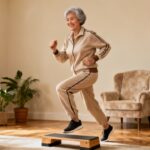Imagine waking up feeling perfectly fine, yet inside your body, a silent threat could be building. In the United States, a stroke occurs every 40 seconds, and after age 50, your risk increases dramatically.
But here’s the empowering truth: up to 80% of strokes are preventable. The solution isn’t found in a miracle pill or an expensive program—it’s in movement.
Simple, consistent exercises can strengthen your heart, enhance blood flow to your brain, and safeguard your independence. Best of all, you don’t need to be a fitness expert. Even if you haven’t exercised in years, you can start safely at home, at your own pace.
This article will guide you through 10 science-backed exercises proven to reduce stroke risk after 50. Each one brings you closer to staying sharp, strong, and stroke-free.
1. Brisk Walking
What if a simple activity like walking could lower your stroke risk by over 40%? A 2023 study in the Journal of Stroke and Cerebrovascular Diseases found that adults over 50 who walk briskly for 30 minutes daily, five times a week, had a 43% lower risk of stroke.
Brisk walking improves blood vessel flexibility, reduces systolic blood pressure, and enhances endothelial function to prevent blockages. Start with 10 minutes at a pace where you can talk but not sing.
Wear supportive shoes and walk on even ground. For an extra boost, take a 10-minute walk after meals to help control blood sugar.
2. Seated or Standing Marches
Don’t let joint pain or balance issues hold you back. Seated or standing marches are a low-impact way to improve blood flow and support brain health right from your living room.
This gentle movement raises your heart rate, activates core and leg muscles, and boosts circulation without stressing your knees.
Sit tall in a chair or stand behind one for support. Lift your right knee toward your chest, lower it, and switch sides. Start with two to three minutes, gradually increasing as you build endurance. Add light arm swings to engage your upper body for even more benefit.
3. Resistance Band Leg Press
Weaker leg muscles can increase stroke risk because your legs help pump blood back to the heart. The resistance band leg press builds strength in your quads, hamstrings, and glutes, which are crucial for circulation and balance.
According to Lancet Neurology, strong lower body muscles are linked to better vascular health and lower stroke risk in older adults.
Sit tall in a chair, loop a resistance band around one foot, and hold the ends. Slowly press your foot forward until your leg is almost straight, then return with control. Do 10-15 reps per leg, increasing resistance or reps as you get stronger.
4. Tai Chi
Often called meditation in motion, Tai Chi combines gentle flowing movements with focused breathing. A 2022 review in Frontiers in Aging Neuroscience found that regular Tai Chi practice improves brain perfusion, balance, and reduces stress hormones like cortisol.
This practice calms your nervous system, enhances coordination, and boosts blood flow to the brain.
You can join a beginner class, follow online videos, or try chair-based Tai Chi for extra support. Aim for 10-15 minutes daily, focusing on slow, deliberate movements that match your breath.
5. Swimming or Water Aerobics
Swimming and water aerobics are excellent for full-body workouts that protect your joints while strengthening your heart.
Aquatic exercise improves cardiovascular endurance and vascular compliance, helping your arteries expand and contract smoothly. The water’s resistance and hydrostatic pressure enhance blood circulation with minimal joint strain.
Try lap swimming, join a water aerobics class, or simply walk or jog in the shallow end. Aim for 20-30 minutes two or three times per week. If you can’t swim, use a float belt or noodle for support.
6. Cycling
Whether on a stationary bike or outdoors, cycling is a heart-smart exercise for adults over 50. A 2021 study in Circulation showed that regular cycling reduces arterial stiffness, improves blood lipid profiles, and lowers stroke risk.
It strengthens leg muscles to aid blood flow back to the heart and brain, and boosts VO2 max, your body’s oxygen use efficiency.
Start with 10 minutes at a moderate pace on a stationary bike, gradually increasing time and resistance.
For outdoor cycling, choose flat, safe roads and wear a helmet. Recumbent bikes or trikes offer added stability if balance is a concern.
7. Gentle or Chair Yoga
Yoga isn’t just for the young or flexible—it’s a powerful tool for aging well. Gentle yoga improves the autonomic nervous system, regulating heart rate, blood pressure, and inflammation, all major stroke risk factors.
It combines slow movement, deep breathing, and mindfulness to enhance blood flow, calm the nervous system, and reduce clot risk.
Try a beginner-friendly class or seated poses. Aim for 15-20 minutes three to four times a week.
Focus on poses like cat-cow for spine flexibility, seated twists for circulation, and legs-up-the-wall for relaxation. Avoid extreme inversions if you have high blood pressure or glaucoma.
8. Light Interval Training
You don’t need to sprint to reap heart benefits. Light interval training alternates gentle movement with short bursts of effort, lowering systolic blood pressure by up to 10 mmHg, as shown in a 2020 Hypertension Research study. It also improves heart rate variability, a key marker of cardiovascular health.
Start with 2 minutes of slow walking or marching in place, followed by 1 minute of brisk movement. Repeat for 15 minutes total. Use upbeat music to make it fun and keep your body adapting for long-term health.
9. Balance Drills
Balance isn’t just about fall prevention—it keeps your brain and body connected. Balance training reduces fall risk by up to 39% and indirectly lowers stroke risk by preventing trauma-induced vascular events. These drills activate the cerebellum, improving coordination and blood flow.
Stand behind a sturdy chair, lift one foot, and hold for 10-15 seconds. Switch sides. As you improve, try without holding the chair. For a challenge, practice heel-to-toe walking across a hallway. These simple exercises train reflexes and protect independence.
10. Diaphragmatic Breathing
Breathing can be a powerful exercise for stroke prevention. Deep diaphragmatic breathing increases oxygen saturation, lowers heart rate, and relaxes blood vessels through nitric oxide release.
Sit comfortably, place one hand on your chest and one on your belly. Inhale slowly through your nose, expanding your belly, not your chest. Exhale gently through pursed lips.
Do this for five minutes daily, especially during stress, to calm your nervous system and improve brain circulation.
Bonus: Head Tilt Pump
This simple move, often used in neuro rehab, boosts blood flow to the brain stem. Sit tall with relaxed shoulders, gently tilt your head to the right, hold for two seconds, return to center, and repeat to the left. Do 10 reps per side once daily to encourage vertebral artery circulation and keep your neck mobile.
Remember, you don’t need to do all these exercises every day. What matters is consistency. Start small—maybe march in place for two minutes today, try deep breathing tomorrow, or walk after lunch next week.
Each step builds energy, mental clarity, and confidence. You have more control over your health than you might think. Keep moving, and you’ll stay stronger and sharper for years to come.








